McLaren’s F1 revolution — by John Barnard
At the start of the decade the Woking team looked a spent force. By 1989 it was invicible. Here, visionary design chief John Barnard looks back on his game-changing partnership with Ron Dennis and the birth of an F1 superpower
Alamy
I finished working for Chaparral in September 1979, although I had been based back at my father’s house in North-west London since about October 1978. I designed the Chaparral 2K in my father’s front room with another base at BS Racing in Luton, where it was made. Having finished the Chaparral I decided the next move for me was to get back into Formula 1. My deal with Jim Hall was that I would be recognised as the chief designer at Chaparral but when I arrived at the Indy 500 in ’79 I saw a massive billboard showing Jim Hall, Al Unser and the Chaparral with the caption “Master of Ground Effect”. I thought, “That’s not right, not the deal,” and went to talk to Jim. I told him, “That’s not what we agreed,” and it all fell apart.
Al Unser left too, so I was now looking for a job in England and knew I wanted to work in Formula 1. Patrick Head told me, “There’s this chap Ron Dennis looking for someone to design him a Formula 2 car,” but I really wanted to do Formula 1. Next thing, I get a call from Ron, and then he appeared at my front door, so I went to look at his set-up in Woking. It was all neat and tidy, but pretty small beans back then. Ron said he wanted to do Formula 1, and we talked about money. He told me if I worked for him for a year at Project 4 and he failed to get the money for F1, then he’d give me another year’s salary, and I accepted that risk. He had this little office, on the mezzanine floor, effectively a garden shed on stilts, and I got my drawing board in there. That’s where it all started.
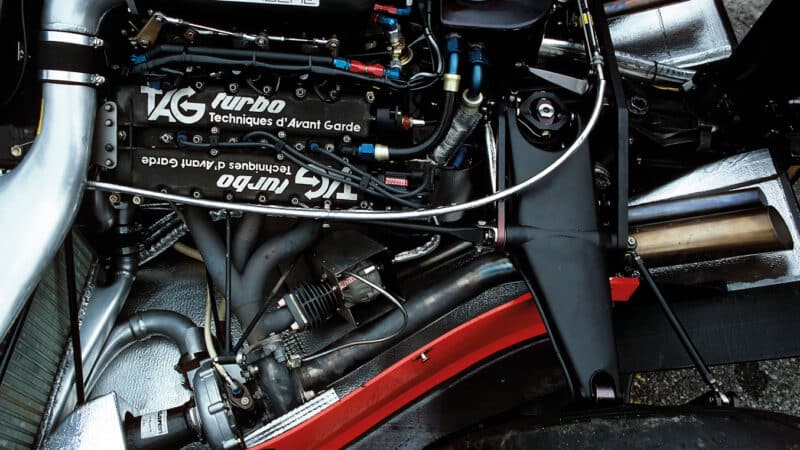
The V6 TAG turbo arrived towards the end of 1983 – due to pressure from Niki Lauda
Getty Images
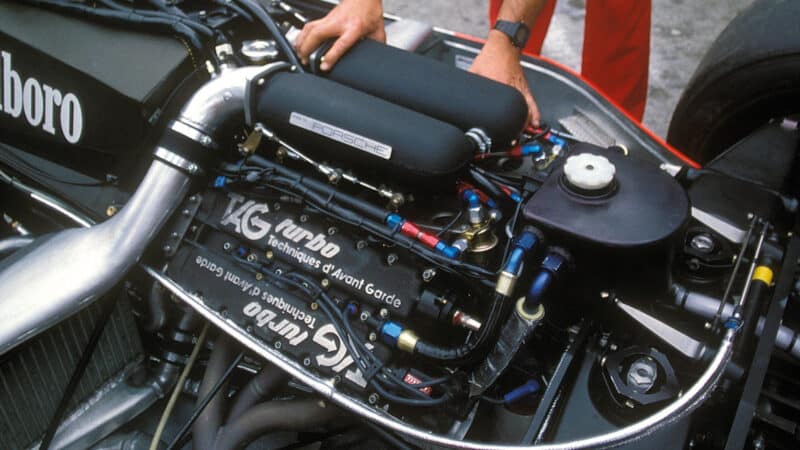
TAG branding, but made by Porsche – Italian GP, 1983
Grand Prix Photo
The reason I went for a composite chassis was that I’d just finished the Chaparral which was the first true ground-effect car at Indianapolis, so I wanted to make a definitive step in Formula 1. I started designing an F1 car for Ron’s Project 4 outfit. The joining of Project 4 and Team McLaren was still a long way off. Lotus had done the 78, the first under-wing car, and then the 79 which came out about the same time as my Chaparral 2K. Williams, meanwhile, was in the wind tunnel trying ground-effect sidepods. I had a lot of time to come up with an F1 car for Project 4, ground effect was the big thing, and so I wanted the biggest, widest sidepods I could get. Then I started looking at the chassis to give me these wide underbodies. I could have made the chassis with steel skins instead of aluminium, but that meant a weight penalty, and carbon panels were around. They’d used some unidirectional fibres in the rear wing endplates of the Embassy Hill. Gordon Murray had glued and riveted a woven carbon panel on the front of the Brabham. So, carbon fibre was out there. I went to BAC at Weybridge to look at the RB211 engine cowlings which were carbon-skinned honeycomb panels. I thought, “If they can make these, then surely I could do that for a racing car.”
I spoke to Arthur Webb, a good old-school engineer, who told me about the do’s and don’ts of working with composites, and started on drawing a moncoque for Ron’s car. I had made a conscious decision to make a step to improve the aerodynamics of the underbodies, how to get the maximum downforce. I don’t think the idea of just how new this idea of working with composites was going to be until it hit Ron further down the road. We had started to go to companies in the UK who were working with composites. I remember one was doing helicopter blades, and they told us we were dreaming, way over the top, that we were trying to build a jet fighter and we hadn’t even built a Tiger Moth yet. We didn’t think much of that kind of attitude, so I spoke to Steve Nichols, a contact from my Indy days, who told me that Hercules had a composite department and we should try talking to them. Ron being Ron was straight on the phone to them, and then we’re on a plane to Salt Lake City with a wind tunnel model in a box.
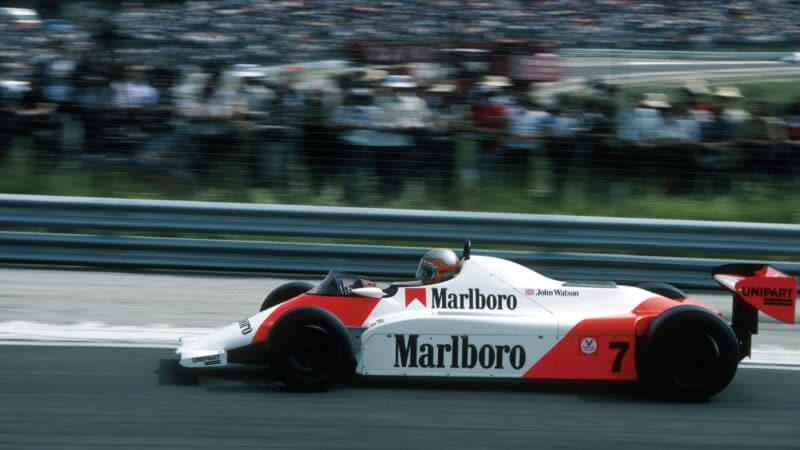
John Watson at Dijon, 1981
Getty Images
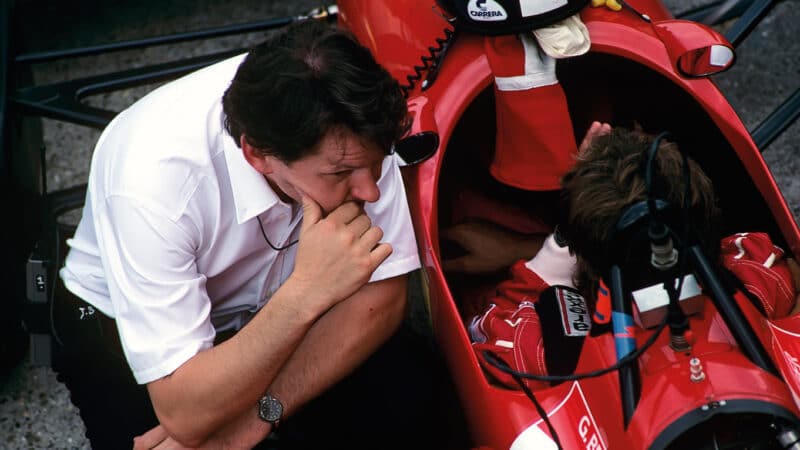
Ferrari’s Barnard is all ears with Gerhard Berger at the 1988 Hungarian GP
Getty Images
Their attitude was so different. They looked at the drawings and said they’d like to have a go at helping us in their R&D department. At the same time Ron was looking for the money to pay for all this, it was getting very near the wire, but John Hogan at Marlboro saved the day. It was John’s idea to get Project 4 and McLaren together, build a new team for F1, and he would sell this idea based on the fact that we were doing something so new with a carbon-fibre chassis.
“It was about us doing something completely new for Formula 1”
It wasn’t about whether we were going to win or lose, it was about us doing something that was simply brand new for Formula 1. John Hogan signed the cheque and without Marlboro we’d never have got the go-ahead and the funds to make it happen.
“Make any shape you want, but you have to avoid joints”
Carbon fibre’s strength to weight was the attraction for me but moving from designing with metal to designing with composites is a huge step. Arthur Webb said to me, “You can make pretty much any shape you want, but you have to avoid joints,” so the whole outer monocoque was one single mould. I was trying to get perfection by eliminating joints but we didn’t have the capability to use a numerically controlled machine that could make a mould tool with a three-dimensional shape. That all came much later.
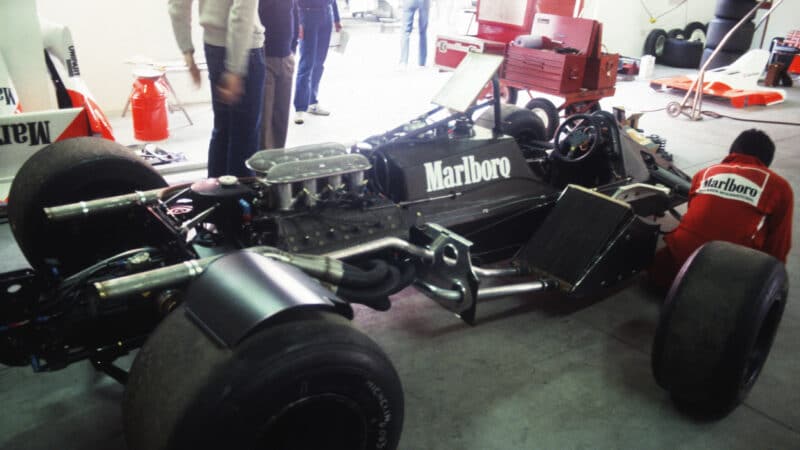
McLaren monocoque, 1981
Grand Prix Photo

Barnard-designed Chaparral 2K – winner of the 1980 Indy 500
Getty Images
Both Ron and I were, still are, perfectionists and that worked in our favour. The dynamic of our working relationship was basically good. I was the perfectionist in terms of design and engineering, Ron was the perfectionist in the set-up, the presentation of the whole thing. The old way at McLaren was that mechanics made bits and pieces themselves for “their cars” and they kept those bits to themselves. This really annoyed me. I wanted everything drawn, and if we change the drawing, then we make it again. The cars should be identical, so no more drivers saying, “This car is better than the other one.” The chief designer has to make it clear what he wants, not the man on the milling machine. Ron would say he didn’t care if the cars were last on the grid, he’d have the smartest garage, the cleanest mechanics, the most ordered team in the pitlane.
When we come to the deal to get the Porsche engine we need to go back to 1981, the first year with the composite car, when I told Ron we needed a turbo engine. Teddy Mayer said he had the drawings for the Renault engine that Lotus were using, and we looked at the BMW, but these were road car engines. The BMW was actually hung in a space frame, so I told Ron we can forget all those. We needed a better engine, so we went through some names, and Ron said, “What about Porsche?” I thought that was never going to happen but he got on the phone to them and we went to see Porsche, showed them the package I wanted. A narrow V6 (we settled on 80 degrees), the pumps on the front of the engine, not down the sides. They had a flange sticking out along the sump line with a bolt in it so I said they had to change that as it would stick into my profile. We would own the design, control how it was made, and Ron got TAG involved. That’s how we paid for it.
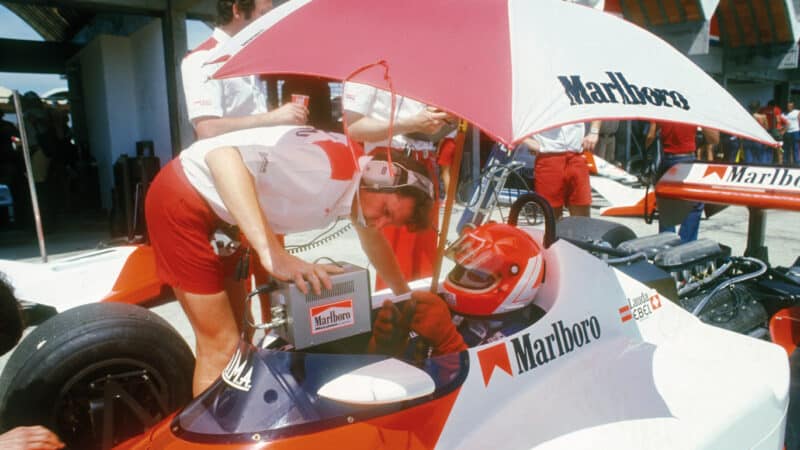
Barnard with Niki Lauda in practice before the 1983 Brazilian GP
Grand Prix Photo
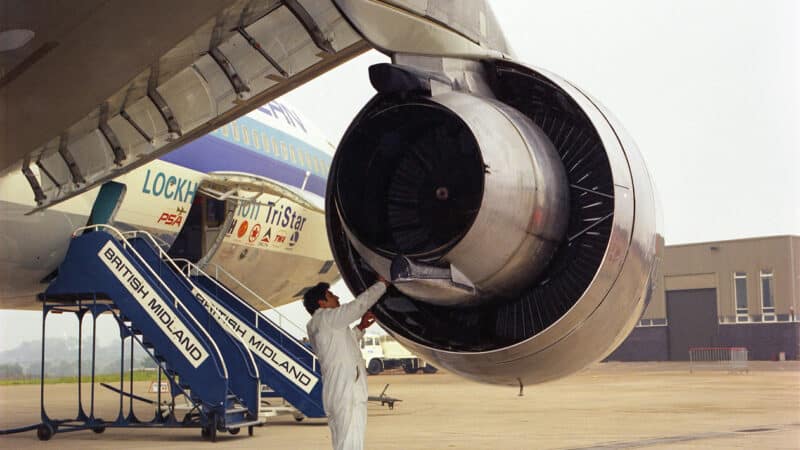
the cowlings of a Rolls-Royce RB211 turbofan engine were an inspiration for Barnard
Getty Images
The drivers, Wattie and de Cesaris, were there at the start in 1981 and they were on board with what we were doing and understood it was a new concept. At the end of 1980 Prost wanted to leave McLaren but Ron wanted him to stay and told him in so many words that he’d regret it if he left. I can’t repeat, in print, exactly what Ron said to him.
Niki Lauda was the reason I had to run the turbo engine at the end of 1983. He put pressure on us to do that. Looking back it was worth doing, but he knew I wasn’t keen, so he pressured Marlboro and Ron to get his way. It was always known as the McLaren-TAG but Porsche was very proud of its success and I could see that when I went to the factory.
We certainly raised the bar in Formula 1. I raised the game on the engineering side, the whole design process, the way things were made. Nothing on the car wasn’t drawn and authorised by the drawing office. We had started the whole process of life-ing the parts but we did very little testing. We just didn’t have enough personnel. In ’84 we had about 75 people in total, so we couldn’t keep building stuff, or test parts until they failed.
Towards the end of ’84 I decided I wanted to cash in my McLaren shares. Teddy Mayer and Tyler Alexander had gone, Ron and I both had 43% of the shares, Creighton Brown had the remaining 14%. I’m not a risk taker, I had a family to look after, and wanted to get my money back from the shares. The result of all that was Ron kept 40%, Mansour Ojjeh took 60% and Creighton sold his holding. I agreed that I’d stay another two years but at the end of ’85 I told Ron I wanted a pay rise and he never came back to me.
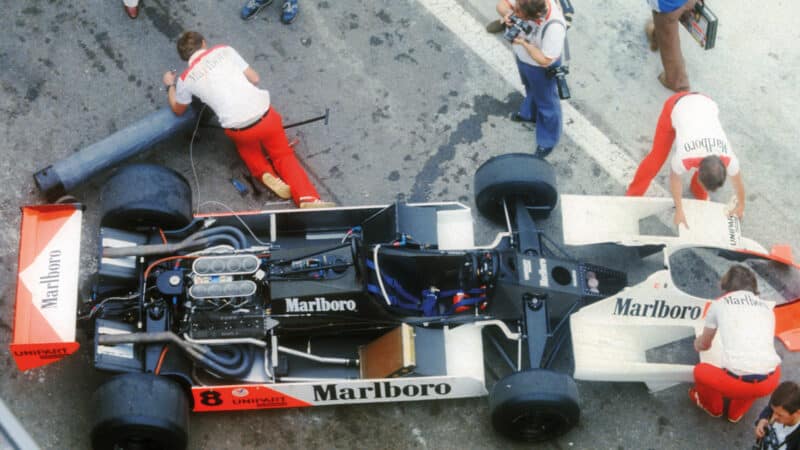
The carbon-fibre core of de Cesaris’s 1981 McLaren MP4/1, with Cosworth power and Marlboro money
Grand Prix Photo
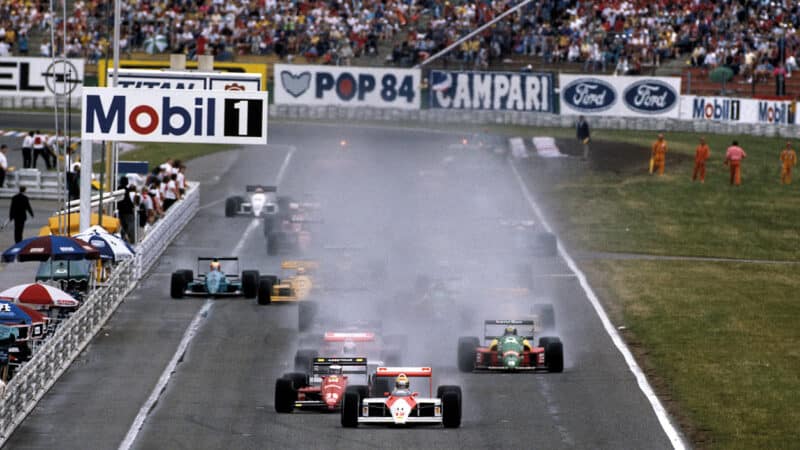
Barnard’s Ferrari, driven by Berger, trails Senna’s McLaren at the German GP, 1988; Berger would be the sole non-McLaren driver to win a GP this season
Getty Images
In that period Marco Piccinini from Ferrari got in touch with me and once they started waving the numbers at me it was difficult to resist. When they said I could set up my own base in England I was persuaded.
“Sometimes I wonder what would have happened if I’d stayed at McLaren”
Sometimes I wonder what would have happened if I’d stayed at McLaren, been technical director when the engine regulations changed and they got Senna with the Honda engine. It would have been very different. McLaren didn’t own the Honda engine like we had with Porsche, and so I would not have had the freedom to do what I wanted with the installation and the engine. In ’88 we had the V6 turbo engine in the Ferrari 87/88C but McLaren dominated with Prost and Senna and the Honda. We were closest to them that year, runners-up in the constructors’, but the Honda had more power.